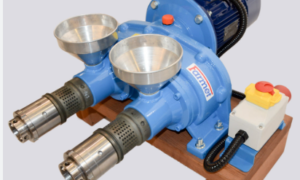Manufacturers rely on ball screws in a variety of applications because they serve as an extremely useful tool. For example, industrial industries often turn to this tool when they will be operating machinery under extreme loads. They know it will do the job. How does a ball screw work, how it is beneficial in industrial applications, and what are some commonly used types? The following guide answers these questions and many more.
What is a Ball Screw?
Originally referred to as an anti-friction nut, ball screws withstand high levels of stress and weight placed on them, minimizing friction in the process. The screw and nut feature helical intentions on both pieces. These indentations allow ball bearings to roll freely between the screw and nut. As the ball screw rotates, the ball bearings move to a return system before they change direction. Ball Screw Manufacturing processes remain popular today for a variety of reasons.
How Do Ball Screws Work?
Ball screws function to transfer rotational movements to linear ones in an application. The ball screw device consists of a nut, threaded shaft, and ball bearings. The ball bearings reduce friction between the other parts when they are in motion.
Industrial Applications for Ball Screws
Rudolph G. Boehm invented this tool in the 1920s, and it continues to be used today. Many industrial applications benefit from the use of ball screws, as they are able to convert motion from one type to another. What makes them so effective in this situation? Where might they be used?
Also, read Glued NOT Screwed – Samsung’s change to screens has reduced phone lifecycles by 50%
Ball Screws Lead to Cost Savings
Extreme loads and high precision remain the hallmarks of most industrial machinery operations. Using a ball screw, the operator can exceed the accuracy and load-bearing capabilities of lead screws, a relative of the ball screw. The ball bearings function to reduce friction within this machinery, resulting in a smooth operation. In addition, they help to extend the lifespan of the equipment.
Industrial machines perform the same action repeatedly in quick succession. This wear and tear can lead to early failure of the machine. Ball screws work to prevent excessive wear and tear while allowing the machine to carry out high-speed movements.
Where Might Ball Screws Be Used in Industrial Applications?
Manufacturers often incorporate ball screws into machine tools and high-precision assembly equipment. Food processing equipment and milling machines function better when they are constructed with ball screws, and the same holds for semiconductor manufacturing equipment. Furthermore, many robotics manufacturers now make use of ball screws in general robotics as well as industrial robots used during the manufacturing process.
Common Types of Ball Screws
All-electric design machines make use of heavy-duty ball screws because they are able to withstand large axial loads. These screws are also found in forging and semiconductor manufacturing equipment as well as air compressors. High-speed ball screws offer high acceleration and rigidity combined with low noise performance and vibration. Furthermore, they are ideal for high-speed feed applications. Manufacturers use this type of ball screw with cutting centres that make use of high-speed abrasive tools and high-speed longitudinal loads. In addition, they employ them in machine tool rapid feed equipment.
Ball screws of the cooling type consist of one body forced in a nut to create a heat source during high-speed operation. This process occurs as a result of thermal expansion. These screws are used with high-speed machine tools as well as longitudinal load processing equipment that operates at high speeds.
In contrast, nut rotating ball screws consist of a ball nut and screw formed into one piece. These screws use linear motion behaviour and are beneficial in a variety of applications. This includes inside industrial robots, woodworking and laser processing machines as well as conveying devices.
Self-lubricating ball screws come with an oil removal device that can be put on and taken off as needed. As a result, it does not need lubrication, which helps to keep oil costs down. However, silent ball screws serve as another option that should not be overlooked. A distinct ball spacer ring shaped like a groove sits positioned between balls to suppress the noise generated when the balls collide. It also suppresses any wear resulting from the balls. As a result, this ball screw is quieter during movement and smoother.
Various other ball screw options exist today. For example, a person might choose a ball screw with a roller on the screw’s surface. This roller functions to roll the thread. Once the screw has undergone heat treatment and polishing, manufacturers assemble it. This screw can be manufactured rapidly at an affordable price.
How Does a Ball Screw Differ from a Lead Screw?
Individuals see a ball screw sitting next to a lead screw and often wonder what makes the two screws different. Lead screws lack the ball bearings present in ball screws. Furthermore, this type of screw doesn’t actively roll. Ball screws, in contrast, feature a nut in which ball bearings circulate. They do so to reduce friction while supporting the load.
The Benefits and Drawbacks of Ball Screws
Manufacturers often turn to ball screws because they know they can rely on the screws’ mechanical efficiency. In fact, research shows these screws offer 90 per cent efficiency compared to the 20 to 25 per cent seen with lead screws. They produce minimal friction thanks to the smooth gliding surface provided by the ball bearings. As a result of the reduced friction, the ball screw lasts longer.
Nevertheless, ball screws remain at risk of being back-driven. Rather than converting rotary movement to linear, they do the exact opposite. This occurs as a result of the lack of friction present. In addition, they come at a higher price tag than similar devices. A manufacturing company with a limited budget might find the cost of ball screws is prohibitive if they wish to remain in business.
Each manufacturer must review all options available to them to find the one that is right for their needs. If cost isn’t a factor, many companies discover the use of ball screws improves the quality and performance of their offerings. Consumers are certain to notice and appreciate this.



































